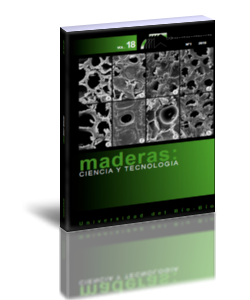Characterization of sorption behavior and mass transfer properties of four central africa tropical woods: Ayous, Sapele, Frake, Lotofa
Keywords:
Air permeability, Central Africa, diffusion coefficient, sorption isotherm, tropical woods.Abstract
This study provides the sorption isotherm, its hysteresis and their mass transfer properties of four Central Africa Tropical woods widely used for building construction: frake (Terminalia Superba), lotofa (Sterculia Rhinopetala), sapele (Entandrophragma Cylindricum) and ayous (Triplochiton Scleroxylon). Characterization of these four species in particular and Central Africa tropical woods in general were necessary to develop conservation and treatment of wood after first transformation using the drying. Also, moisture transport on wooden material used such as wall buildings can be facilitating to found the thermal comfort. Measurements of isotherms were performed using a dynamic vapor sorption apparatus (Surface Measurement Systems) at 20 and 40°C with air relative humidity ranged from 0% to 90%. Mass diffusivity was determined in steady state using a specific vaporimeter. Air permeability was determined using a specialized device developed to measure over a wide range of permeability values. Permeability and mass transfer properties were determined in the tangential direction with a ‘’false’’ quartersawn board (sapele and lotofa) and in the radial direction with a flatsawn board (ayous and frake). Samples of sapele, ayous and frake are heartwood when lotofa contains as well as heartwood than sapwood. Results obtained showed that the temperature effect on sorption behavior was quite low. We observed also a low difference between the sorption behavior of these different species and hysteresis of sorption decreases when temperature increases. Hailwood-Horrobin model’s explains plausibly the experimental sorption isotherms data. Results on characterization of mass transfer properties showed that, in the steady state, mass diffusivity decreases exponentially when basal density increases. Mass diffusivity was higher in desorption than in adsorption phase. The gaseous permeability of these species was between than those of Australian hardwoods and temperate woods. It was difficult to define a relationship between permeability and mass diffusivity.Downloads
Download data is not yet available.
Downloads
How to Cite
Simo-Tagne, M., Rémond, R., Rogaume, Y., Zoulalian, A., & Perré, P. (2016). Characterization of sorption behavior and mass transfer properties of four central africa tropical woods: Ayous, Sapele, Frake, Lotofa. Maderas. Ciencia Y Tecnología, 18(1), 207–226. Retrieved from https://revistas.ubiobio.cl/index.php/MCT/article/view/2256
Issue
Section
Article

































